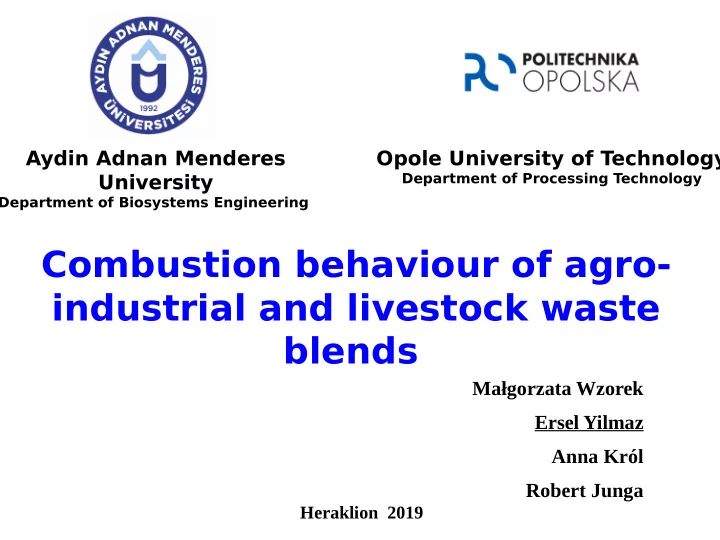

Aydin Adnan Menderes Opole University of Technology University Department of Processing Technology Department of Biosystems Engineering Combustion behaviour of agro- industrial and livestock waste blends Małgorzata Wzorek Ersel Yilmaz Anna Król Robert Junga Heraklion 2019
Agro-industrial Waste Source: M.Yusuf, Handbook of Ecomaterials, 2017
Applications of agro-industral waste
The aim of the work is to study thermal decomposition of selected agro-industrial waste and animal livestock burned alone and their blends via termogravimetric analyses to determinate the conditions of the combustion process for their application as fuel.
Materials Turkey Poland Cotton stalk (CS) Rapeseed oil cake (ROC) Camel manure (CAM) Cow manure (COM)
Materials In order to identify the blends - pellets, individual symbols were attributed to them: • CAM90 – 90% camel manure and 10% cotton stalk • CAM80 – 80% camel manure and 20% cotton stalk • COM90 – 90% cow manure and 10% rapeseed oil cake • COM70 – 70% cow manure and 30% rapeseed oil cake
Pelletization 1 – dosing funnel equipped with a feeding screw, 2 – replaceable sieve, 3 – cutting element, 4 – feeding screw motor. Sieve φ - 8 mm
Pellets produced on the basis of animal waste and agro-industrial waste 90% camel manure and 10% cotton stalk 70% cow manure and 30% rapeseed oil cake CAM90 COM70
Methods 1. The energy parameters : • moisture - PN-EN ISO 18134 • ash - PN-EN ISO 18122 and PN-ISO 117 • volatile matter - PN-EN ISO 18123 • elementary analysis using Vario Macro Cube analyser 2. • higher heating value (HHV) with the use of the IKA Calorimeters C 5000 according to PN-EN 14918:2010 and PN-ISO 1928 standard 2. The simultaneous thermal analysis (TG-DTG) and (DSC) was carried out in NETZSCH STA 449 F3 Jupiter device. • in a dry air atmosphere with the gas fmow of 70 mL/min • temperature up to 1,000 o C • heating rate: 10 K/min
The proximate and ultimate analysis of tested biomass and blends
TG/DTG curves: cotton stalk (CS) and rapeseed oil cake (ROC) camel manure (CAM) and caw manure (COM)
TG/DTG curves of blends: camel manure and cotton stalk (CAM) caw manure and rapeseed oil ca
Temperature ranges of combustion stages S ta g e II S ta g e III S ta g e IV S a m ple o C o C o C CS 176-372 372-530 - ROC 150-420 420-781 - CAM 157-360 360-445 445-565 COM 158-347 347-448 448-545 CAM90 163-365 365-440 440-585 CAM80 156-362 362-421 421-540 COM90 152-368 368-625 - COM70 160-371 371-468 468-652
Ignition temperature T i , temperature of end combustion T b and total combustion time t b
The maximum values of peaks on the DTG (Difgerential Thermogravimetry) and DSC (Difgerential Scanning Calorimetry) curves and their temperatures at individual stages of combustion S t a g e II S t a g e III S t a g e IV DTG DS C DTG DS C DTG DS C Sample Mass Max. heat Mass Max. heat Mass loss Max. heat T Max T II T Max II T III T Max III T IV loss rate release loss rate release rate release IV o C o C o C o C o C o C %/min MW/mg %/min MW/mg %/min MW/mg CS -7.86 294.6 9.50 315.7 -4.27 449.1 17.87 455.6 - - - - ROC -4.23 323.8 6.47 341.6 -2.79 515.6 12.35 514.5 - - - - CAM -9.45 291.7 12.53 311.5 -2.50 400.0 9.08 406.2 -2.14 468.4 10.04 469.6 COM -10.06 301.2 14.08 313.1 -3.02 385.9 9.90 399.6 -1.41 462.2 7.02 463.3 CAM90 -8.62 291.5 9.75 315.9 -2.39 418.8 8.93 423.7 -2.89 463.0 12.06 465.9 CAM80 -8.69 290.8 10.08 313.5 -2.41 403.4 13.05 451.0 -3.48 445.3 - - COM90 -8.39 306.9 12.08 319.4 -2.63 403.5 9.67 423.5 - - - - COM70 -7.67 310.3 11.56 323.2 -2.44 415.1 9.27 433.0 -1.46 486.6 7.71 487.7
DSC curves of tested biomass cotton stalk (CS) and rapeseed oil cake (ROC) camel manure (CAM) and caw manu (COM)
DSC curves of blends camel manure and cotton stalk (CAM) caw manure and rapeseed oi cake (COM)
Conclusions • Thermal degradation of studied biomass and their blends shows three main stages: moisture evaporation, volatilization of the light molecules, and char combustion. • For combusting blends, what has a decisive impact on the burning profjle is the component occurring in the highest amount. The efgect grows stronger as there is more of this component. • Blend COM70 – (70% cow manure and 30% rapeseed oil cake) is recommended to application as a fuel because of proper energy parameters and combustion behaviour as well as mechanical strength of pellets.
Thank you for your attention
Recommend
More recommend